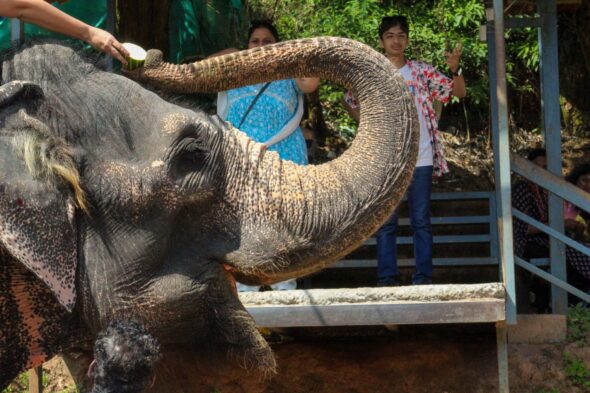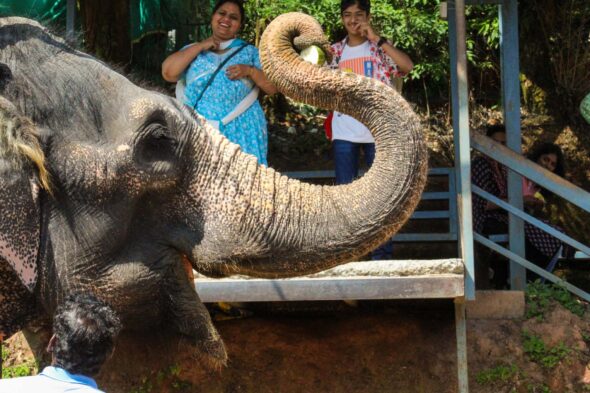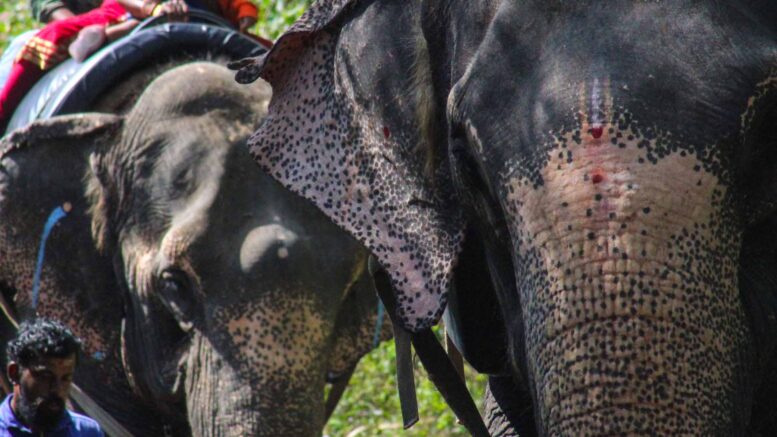By Meoghan Swain
I had never seen an elephant before. Not in real life, anyway. So when I booked my flight to India, I was eager to do three things: experience the culture, eat the food and see an elephant with my own eyes.
Luckily, I did manage to gaze upon these majestic creatures; I just didn’t expect them to be in chains.
Elephants are heavily engraved in Indian culture. No matter the region or religion, elephants are widely respected throughout the country, or at least seemingly so.
Statues and moldings of them reside in the homes of locals, they’re pictured in Indian clothing and art, and they’re especially represented in various religions practiced throughout India. After all, the elephants have been here longer than the humans have.
Because of this representation, I pictured elephants being part of the vast nature and wildlife I had been so heavily immersed in since stepping off the plane.
I hadn’t come to India for the crowded streets and the Taj Mahal. I came for the green mountains and tea fields, and whatever else I found out in the countryside of Munnar.
So, I figured seeing elephants here would be just as magnificent, beautiful and wild as the mountains and waterfalls I’d been exploring just a few days before. I carried this idea with me when I got in a taxi, heading towards something called an “elephant safari.”
What I saw was not a herd of elephants grazing by a stream, but herds of people waiting in line to ride on the backs of the animals as if they were a ride at an amusement park. There were only three or four elephants in total, with ears and trunks beautifully painted and chains wrapped around their ankles.
In a way, I could see how the tourists in line overlooked this kind of abuse.
I remember a family was given fruit to feed the elephant while still on its back. The little boy, maybe no more than four years old, held the fruit out above the elephant’s head.
As he did this, the elephant threw her trunk back, grabbed the treat, and amazingly curled her trunk in front of her to eat the fruit. It was a wonderful trick to watch.
As it was the first time I had ever seen an elephant up close, even I was in awe. And seeing the smile on the boy’s face made me forget what was really going on in front of me. For him, I’m sure that moment will become a core memory.
An unforgettable vacation with his mother and father. But what did that beautiful creature have to endure to make that moment happen?



Needless to say, my partner and I opted out of the “elephant safari” and got back in the taxi feeling conflicted … uneasy. I was still half on a high from seeing these magnificent animals for the first time…magnificent, but chained.
One thought ran through my mind: If this was happening here, where else do India’s elephants share the same fate?
Munnar is a southern city in the state of Kerala that is scarcely known to tourists not native to India. Many locals asked us how we heard about Munnar, as they don’t often meet outsiders.
If this kind of animal abuse and captivity is happening in a small and unpopular part of the country, where else could it be happening?
I had a gut feeling that I was a witness to a small example of a much larger issue, and I was right.
I got back to the States, hopped on my computer and found myself thankful I had seen a mild example of elephant abuse happening throughout India. At least 77 percent of captive elephants in India and Southeast Asia are chained night and day, according to The Guardian.
One of the largest locations for elephant rides is in Jaipur, a city located in northern India and 2,300 km away from Munnar, where life and religion differ.
Here, elephants act as Uber drivers as they haul tourists and luggage up steep hills in blistering heat, all the while decorated with painted faces, according to the People for the Ethical Treatment of Animals (PETA).
However, elephant abuse has different disguises throughout the country. Along with elephant rides, the animals are forced to become circus acts, drag and lift timber and even participate in religious ceremonies.
This is all able to happen because of the elephant training process – a horrific act of violence and disregard for the beauty of life.
Elephants are taken from their protective mothers as babies, forever separated, whether they were born in the wild or captivity. They are then beaten into submission with chains and bull-hooks until they are willing to take orders. According to PETA, this is known as the “breaking process.”
Aside from the obvious abuse, this process is mentally damaging to elephants, being the social creatures they are. Their relationships are similar to those of humans, in the sense that they need to socialize with other members of their species. Without this, they tend to fall into depression just as we do when we feel lonely and isolated.
In the wild, elephants migrate for many miles a day. Therefore, they are likely to develop severe joint diseases while restricted in captivity. These conditions cause many other health problems that result in captive elephants dying decades before their expected life span.
This mistreatment and ignorance of natural life is particularly interesting given India’s religious practices. Hinduism and Buddhism similarly hold elephants on a high pedestal as they often are representative of Gods.
Ganesh is an important Hindu figure, an elephant-headed God who provides prosperity, fortune and success. To pay tribute to Ganesh, elephants (usually males used for their mighty tusks) are brought into the temple during ceremonies – a sign of respect to Ganesh, perhaps, but this act shows little respect to the living, breathing animal who is representative of their God.
Siddharta Gautama, the “Buddha” is often represented as an elephant. Before his birth, his mother had a dream that she would give birth to a white elephant, which has become a popular symbol within Buddhism.
It is interesting that, despite the spiritual love many Indians have for this creature, many do not have the same respect for it in the physical world. While their religions are being practiced and their money comes in from tourism, the wild elephant population is diminishing every day.
I think back to my excitement, naively imagining I would see my first elephant grazing in the hills of Munnar, free to wander as it pleased. Instead, I saw Gods in chains.
I saw the power we as humans have that day. The power to destroy, occupy and enslave entire species is inside every one of us. At the same time, we also have the power to advocate for those who cannot – those who are broken down and have no other way out. We have the power to save these elephants.
Together, I believe we can put an end to Asian elephant abuse, and it begins with small gestures. If traveling in the area, opt out of elephant rides … the pictures are not worth the abuse.
You can also donate through PETA – a prominent organization that supports the ethical treatment of animals – as well as other organizations seeking to end this abuse. Donations are welcomed at https://support.peta.org/page/4050/action/1?locale=en-US.
Most importantly, you can share stories like this with friends, peers and on social media. Change cannot happen if the world is ignorant to the issue. Be the voice for India’s elephants and ensure that voice is heard.



Be the first to comment on "Gods in chains"